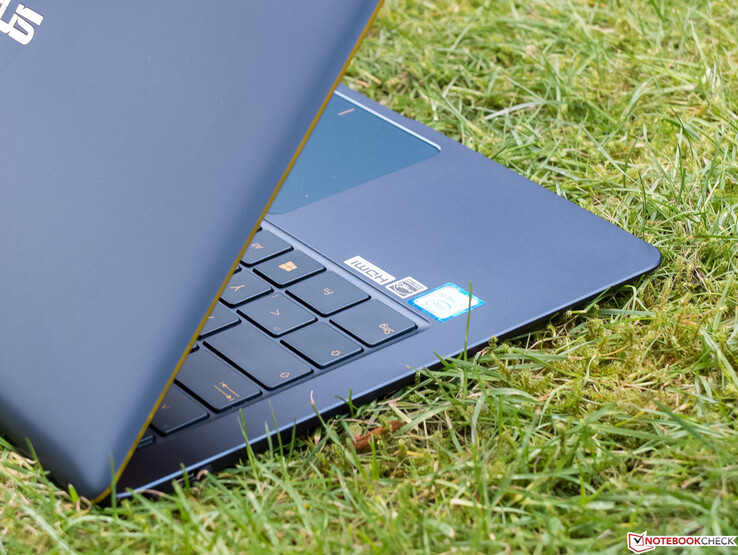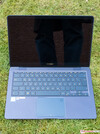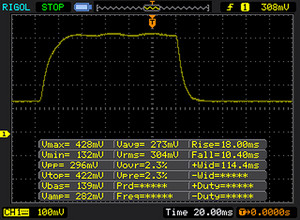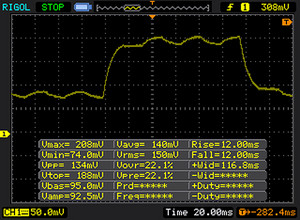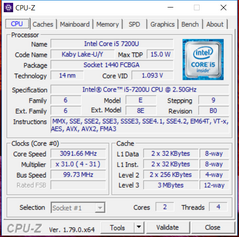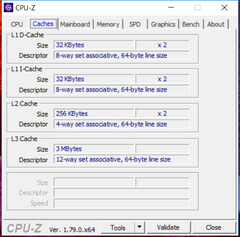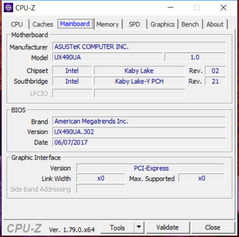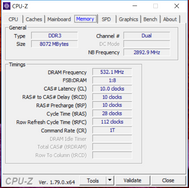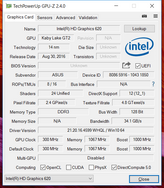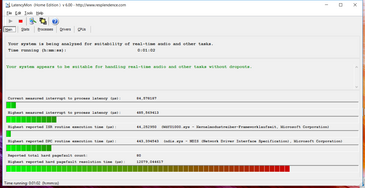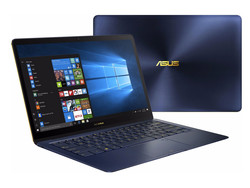Breve Análise do Subportátil Asus ZenBook 3 Deluxe UX490UA (i5-7200U, SSD de 256 GB)
Os Top 10
» Os Top 10 Portáteis Multimídia
» Os Top 10 Portáteis de Jogos
» Os Top 10 Portáteis Leves para Jogos
» Os Top 10 Portáteis Acessíveis de Escritório/Empresariais
» Os Top 10 Portáteis Premium de Escritório/Empresariais
» Os Top 10 dos Portáteis Workstation
» Os Top 10 Subportáteis
» Os Top 10 Ultrabooks
» Os Top 10 Conversíveis
» Os Top 10 Tablets
» Os Top 10 Smartphones
» A melhores Telas de Portáteis Analisadas Pela Notebookcheck
» Top 10 dos portáteis abaixo dos 500 Euros da Notebookcheck
» Top 10 dos Portáteis abaixo dos 300 Euros
Size Comparison
| Networking | |
| iperf3 transmit AX12 | |
| Asus Zenbook 3 Deluxe UX490UA | |
| Huawei MateBook X | |
| Fujitsu LifeBook U937 | |
| Asus ZenBook 13 UX331UN | |
| iperf3 receive AX12 | |
| Fujitsu LifeBook U937 | |
| Asus ZenBook 13 UX331UN | |
| Asus Zenbook 3 Deluxe UX490UA | |
| Huawei MateBook X | |
| |||||||||||||||||||||||||
iluminação: 81 %
iluminação com acumulador: 337 cd/m²
Contraste: 1605:1 (Preto: 0.21 cd/m²)
ΔE ColorChecker Calman: 4.89 | ∀{0.5-29.43 Ø4.78}
ΔE Greyscale Calman: 4.28 | ∀{0.09-98 Ø5}
87% sRGB (Argyll 1.6.3 3D)
56% AdobeRGB 1998 (Argyll 1.6.3 3D)
59.9% AdobeRGB 1998 (Argyll 3D)
86.9% sRGB (Argyll 3D)
58.7% Display P3 (Argyll 3D)
Gamma: 2.25
CCT: 7352 K
| Asus Zenbook 3 Deluxe UX490UA AU Optronics AUO383D / B140HAN03.8, , 1920x1080, 14" | Fujitsu LifeBook U937 Sharp SHP1483, LQ133M1JW28, , 1920x1080, 13.3" | Asus ZenBook 13 UX331UN B133HAN04.9, , 1920x1080, 13.3" | Huawei MateBook X Chi Mei CMN8201 / P130ZDZ-EF1, , 2160x1440, 13.3" | |
|---|---|---|---|---|
| Display | 16% | 10% | 12% | |
| Display P3 Coverage (%) | 58.7 | 68.6 17% | 65.4 11% | 65.8 12% |
| sRGB Coverage (%) | 86.9 | 98 13% | 93.1 7% | 96.2 11% |
| AdobeRGB 1998 Coverage (%) | 59.9 | 70.4 18% | 66.4 11% | 66.8 12% |
| Response Times | -17% | -2% | -12% | |
| Response Time Grey 50% / Grey 80% * (ms) | 24 ? | 39.2 ? -63% | 22.4 ? 7% | 33 ? -38% |
| Response Time Black / White * (ms) | 28 ? | 20 ? 29% | 31.2 ? -11% | 24 ? 14% |
| PWM Frequency (Hz) | 211.9 ? | |||
| Screen | -1% | -3% | 12% | |
| Brightness middle (cd/m²) | 337 | 353 5% | 338 0% | 408 21% |
| Brightness (cd/m²) | 295 | 347 18% | 321 9% | 395 34% |
| Brightness Distribution (%) | 81 | 81 0% | 90 11% | 88 9% |
| Black Level * (cd/m²) | 0.21 | 0.33 -57% | 0.35 -67% | 0.45 -114% |
| Contrast (:1) | 1605 | 1070 -33% | 966 -40% | 907 -43% |
| Colorchecker dE 2000 * | 4.89 | 3.5 28% | 4.2 14% | 1.55 68% |
| Colorchecker dE 2000 max. * | 8.43 | 6.9 18% | 6.5 23% | 2.19 74% |
| Greyscale dE 2000 * | 4.28 | 4.9 -14% | 3.9 9% | 1.91 55% |
| Gamma | 2.25 98% | 2.21 100% | 2.43 91% | 2.34 94% |
| CCT | 7352 88% | 7136 91% | 7144 91% | 6491 100% |
| Color Space (Percent of AdobeRGB 1998) (%) | 56 | 63.5 13% | 60.4 8% | 61 9% |
| Color Space (Percent of sRGB) (%) | 87 | 98.1 13% | 93.1 7% | 96 10% |
| Média Total (Programa/Configurações) | -1% /
0% | 2% /
-0% | 4% /
9% |
* ... menor é melhor
Exibir tempos de resposta
| ↔ Tempo de resposta preto para branco | ||
|---|---|---|
| 28 ms ... ascensão ↗ e queda ↘ combinadas | ↗ 18 ms ascensão | |
| ↘ 10 ms queda | ||
| A tela mostra taxas de resposta relativamente lentas em nossos testes e pode ser muito lenta para os jogadores. Em comparação, todos os dispositivos testados variam de 0.1 (mínimo) a 240 (máximo) ms. » 70 % de todos os dispositivos são melhores. Isso significa que o tempo de resposta medido é pior que a média de todos os dispositivos testados (20.2 ms). | ||
| ↔ Tempo de resposta 50% cinza a 80% cinza | ||
| 24 ms ... ascensão ↗ e queda ↘ combinadas | ↗ 12 ms ascensão | |
| ↘ 12 ms queda | ||
| A tela mostra boas taxas de resposta em nossos testes, mas pode ser muito lenta para jogadores competitivos. Em comparação, todos os dispositivos testados variam de 0.165 (mínimo) a 636 (máximo) ms. » 33 % de todos os dispositivos são melhores. Isso significa que o tempo de resposta medido é melhor que a média de todos os dispositivos testados (31.6 ms). | ||
Cintilação da tela / PWM (modulação por largura de pulso)
| Tela tremeluzindo / PWM não detectado | ||
[pwm_comparison] Em comparação: 53 % de todos os dispositivos testados não usam PWM para escurecer a tela. Se PWM foi detectado, uma média de 8111 (mínimo: 5 - máximo: 343500) Hz foi medida. | ||
| Cinebench R15 | |
| CPU Single 64Bit | |
| Asus ZenBook 13 UX331UN | |
| Asus Zenbook 3 Deluxe UX490UA | |
| Fujitsu LifeBook U937 | |
| Huawei MateBook X | |
| CPU Multi 64Bit | |
| Asus ZenBook 13 UX331UN | |
| Asus Zenbook 3 Deluxe UX490UA | |
| Fujitsu LifeBook U937 | |
| Huawei MateBook X | |
| PCMark 8 | |
| Home Score Accelerated v2 | |
| Asus ZenBook 13 UX331UN | |
| Asus Zenbook 3 Deluxe UX490UA | |
| Fujitsu LifeBook U937 | |
| Huawei MateBook X | |
| Work Score Accelerated v2 | |
| Asus ZenBook 13 UX331UN | |
| Asus Zenbook 3 Deluxe UX490UA | |
| Fujitsu LifeBook U937 | |
| Huawei MateBook X | |
| PCMark 8 Home Score Accelerated v2 | 3632 pontos | |
| PCMark 8 Work Score Accelerated v2 | 4695 pontos | |
| PCMark 10 Score | 3425 pontos | |
Ajuda | ||
| Asus Zenbook 3 Deluxe UX490UA Micron 1100 MTFDDAV256TBN | Fujitsu LifeBook U937 Samsung CM871a MZNTY256HDHP | Asus ZenBook 13 UX331UN SanDisk SD8SN8U512G1002 | Huawei MateBook X LITEON CB1-SD256 | |
|---|---|---|---|---|
| CrystalDiskMark 3.0 | 15% | -2% | 29% | |
| Read Seq (MB/s) | 435.3 | 509 17% | 430.6 -1% | 741 70% |
| Write Seq (MB/s) | 413.3 | 462.3 12% | 424.1 3% | 461.2 12% |
| Read 512 (MB/s) | 325.9 | 385.1 18% | 275 -16% | 504 55% |
| Write 512 (MB/s) | 357 | 228.5 -36% | 369.8 4% | 310.3 -13% |
| Read 4k (MB/s) | 26.28 | 34.85 33% | 28.04 7% | 29.48 12% |
| Write 4k (MB/s) | 85.6 | 90.5 6% | 53.5 -37% | 68.1 -20% |
| Read 4k QD32 (MB/s) | 246.7 | 392.8 59% | 322.9 31% | 498.9 102% |
| Write 4k QD32 (MB/s) | 224.4 | 253.6 13% | 211.9 -6% | 257.5 15% |
| 3DMark 11 - 1280x720 Performance GPU | |
| Asus ZenBook 13 UX331UN | |
| Asus Zenbook 3 Deluxe UX490UA | |
| Huawei MateBook X | |
| Fujitsu LifeBook U937 | |
| 3DMark | |
| 1280x720 Cloud Gate Standard Graphics | |
| Asus ZenBook 13 UX331UN | |
| Asus Zenbook 3 Deluxe UX490UA | |
| Fujitsu LifeBook U937 | |
| Huawei MateBook X | |
| 1920x1080 Fire Strike Graphics | |
| Asus ZenBook 13 UX331UN | |
| Asus Zenbook 3 Deluxe UX490UA | |
| Fujitsu LifeBook U937 | |
| Huawei MateBook X | |
| 3DMark 11 Performance | 1781 pontos | |
| 3DMark Cloud Gate Standard Score | 6056 pontos | |
| 3DMark Fire Strike Score | 934 pontos | |
Ajuda | ||
| baixo | média | alto | ultra | |
|---|---|---|---|---|
| The Witcher 3 (2015) | 14.3 | |||
| Rise of the Tomb Raider (2016) | 20.4 | |||
| Farming Simulator 17 (2016) | 48.6 |
Barulho
| Ocioso |
| 30.2 / 30.2 / 31.2 dB |
| Carga |
| 35.7 / 34.2 dB |
 | ||
30 dB silencioso 40 dB(A) audível 50 dB(A) ruidosamente alto |
||
min: | ||
(+) A temperatura máxima no lado superior é 33.3 °C / 92 F, em comparação com a média de 34.3 °C / 94 F , variando de 21.2 a 62.5 °C para a classe Office.
(+) A parte inferior aquece até um máximo de 33.2 °C / 92 F, em comparação com a média de 36.8 °C / 98 F
(+) Em uso inativo, a temperatura média para o lado superior é 25.4 °C / 78 F, em comparação com a média do dispositivo de 29.5 °C / ### class_avg_f### F.
(+) Os apoios para as mãos e o touchpad são mais frios que a temperatura da pele, com um máximo de 30.4 °C / 86.7 F e, portanto, são frios ao toque.
(-) A temperatura média da área do apoio para as mãos de dispositivos semelhantes foi 27.6 °C / 81.7 F (-2.8 °C / -5 F).
Asus Zenbook 3 Deluxe UX490UA análise de áudio
(-) | alto-falantes não muito altos (###valor### dB)
Graves 100 - 315Hz
(±) | graves reduzidos - em média 13.5% menor que a mediana
(+) | o baixo é linear (6.1% delta para a frequência anterior)
Médios 400 - 2.000 Hz
(+) | médios equilibrados - apenas 2.9% longe da mediana
(+) | médios são lineares (4.3% delta para frequência anterior)
Altos 2 - 16 kHz
(+) | agudos equilibrados - apenas 2.8% longe da mediana
(+) | os máximos são lineares (4.4% delta da frequência anterior)
Geral 100 - 16.000 Hz
(±) | a linearidade do som geral é média (15.4% diferença em relação à mediana)
Comparado com a mesma classe
» 14% de todos os dispositivos testados nesta classe foram melhores, 4% semelhantes, 82% piores
» O melhor teve um delta de 7%, a média foi 21%, o pior foi 53%
Comparado com todos os dispositivos testados
» 22% de todos os dispositivos testados foram melhores, 4% semelhantes, 74% piores
» O melhor teve um delta de 4%, a média foi 24%, o pior foi 134%
Fujitsu LifeBook U937 análise de áudio
(+) | os alto-falantes podem tocar relativamente alto (###valor### dB)
Graves 100 - 315Hz
(-) | quase nenhum baixo - em média 31.6% menor que a mediana
(+) | o baixo é linear (3.5% delta para a frequência anterior)
Médios 400 - 2.000 Hz
(±) | médios reduzidos - em média 7.3% menor que a mediana
(±) | a linearidade dos médios é média (8.4% delta para frequência anterior)
Altos 2 - 16 kHz
(±) | máximos mais altos - em média 9.2% maior que a mediana
(±) | a linearidade dos máximos é média (7% delta para frequência anterior)
Geral 100 - 16.000 Hz
(-) | o som geral não é linear (33.4% diferença em relação à mediana)
Comparado com a mesma classe
» 95% de todos os dispositivos testados nesta classe foram melhores, 1% semelhantes, 4% piores
» O melhor teve um delta de 5%, a média foi 18%, o pior foi 53%
Comparado com todos os dispositivos testados
» 92% de todos os dispositivos testados foram melhores, 1% semelhantes, 7% piores
» O melhor teve um delta de 4%, a média foi 24%, o pior foi 134%
Asus ZenBook 13 UX331UN análise de áudio
(+) | os alto-falantes podem tocar relativamente alto (###valor### dB)
Graves 100 - 315Hz
(-) | quase nenhum baixo - em média 16.9% menor que a mediana
(±) | a linearidade dos graves é média (9% delta para a frequência anterior)
Médios 400 - 2.000 Hz
(+) | médios equilibrados - apenas 4.3% longe da mediana
(+) | médios são lineares (4.2% delta para frequência anterior)
Altos 2 - 16 kHz
(+) | agudos equilibrados - apenas 1.8% longe da mediana
(+) | os máximos são lineares (3.4% delta da frequência anterior)
Geral 100 - 16.000 Hz
(+) | o som geral é linear (14.4% diferença em relação à mediana)
Comparado com a mesma classe
» 28% de todos os dispositivos testados nesta classe foram melhores, 6% semelhantes, 66% piores
» O melhor teve um delta de 5%, a média foi 18%, o pior foi 53%
Comparado com todos os dispositivos testados
» 17% de todos os dispositivos testados foram melhores, 4% semelhantes, 79% piores
» O melhor teve um delta de 4%, a média foi 24%, o pior foi 134%
Huawei MateBook X análise de áudio
(-) | alto-falantes não muito altos (###valor### dB)
Graves 100 - 315Hz
(±) | graves reduzidos - em média 8.3% menor que a mediana
(±) | a linearidade dos graves é média (7.6% delta para a frequência anterior)
Médios 400 - 2.000 Hz
(+) | médios equilibrados - apenas 3.3% longe da mediana
(+) | médios são lineares (6.2% delta para frequência anterior)
Altos 2 - 16 kHz
(+) | agudos equilibrados - apenas 2.6% longe da mediana
(+) | os máximos são lineares (6.6% delta da frequência anterior)
Geral 100 - 16.000 Hz
(+) | o som geral é linear (14.7% diferença em relação à mediana)
Comparado com a mesma classe
» 30% de todos os dispositivos testados nesta classe foram melhores, 5% semelhantes, 65% piores
» O melhor teve um delta de 5%, a média foi 18%, o pior foi 53%
Comparado com todos os dispositivos testados
» 18% de todos os dispositivos testados foram melhores, 4% semelhantes, 77% piores
» O melhor teve um delta de 4%, a média foi 24%, o pior foi 134%
| desligado | |
| Ocioso | |
| Carga |
|
Key:
min: | |
| Asus Zenbook 3 Deluxe UX490UA i5-7200U, HD Graphics 620, Micron 1100 MTFDDAV256TBN, IPS, 1920x1080, 14" | Fujitsu LifeBook U937 i5-7200U, HD Graphics 620, Samsung CM871a MZNTY256HDHP, IPS, 1920x1080, 13.3" | Asus ZenBook 13 UX331UN i5-8550U, GeForce MX150, SanDisk SD8SN8U512G1002, IPS LED, 1920x1080, 13.3" | Huawei MateBook X i5-7200U, HD Graphics 620, LITEON CB1-SD256, , 2160x1440, 13.3" | |
|---|---|---|---|---|
| Power Consumption | -6% | -31% | -51% | |
| Idle Minimum * (Watt) | 3.3 | 3.11 6% | 2.7 18% | 4.6 -39% |
| Idle Average * (Watt) | 6.1 | 6.1 -0% | 5.3 13% | 11 -80% |
| Idle Maximum * (Watt) | 10.1 | 6.75 33% | 6.2 39% | 12 -19% |
| Load Average * (Watt) | 24.6 | 28.9 -17% | 37.6 -53% | 39.5 -61% |
| Load Maximum * (Watt) | 22 | 33.3 -51% | 60.1 -173% | 34.6 -57% |
* ... menor é melhor
| Asus Zenbook 3 Deluxe UX490UA i5-7200U, HD Graphics 620, 46 Wh | Fujitsu LifeBook U937 i5-7200U, HD Graphics 620, 50 Wh | Asus ZenBook 13 UX331UN i5-8550U, GeForce MX150, 50 Wh | Huawei MateBook X i5-7200U, HD Graphics 620, 40 Wh | |
|---|---|---|---|---|
| Duração da bateria | 11% | -2% | -29% | |
| Reader / Idle (h) | 17.2 | 19.2 12% | 22 28% | 8.5 -51% |
| WiFi v1.3 (h) | 9.4 | 10.9 16% | 8.4 -11% | 5.6 -40% |
| Load (h) | 2.6 | 2.7 4% | 2 -23% | 2.7 4% |
| H.264 (h) | 11.9 | 9.6 |
Pro
Contra
Se você leu a análise completa, certamente concordará que, neste momento, ainda não podemos publicar pontuações finais para o ZenBook 3 Deluxe e desativamos nosso widget de pontuação em concordância. Se os erros constantes acabarem por ser uma questão sistemática, que não assumimos neste momento, isso reduziria a pontuação do ZenBook drasticamente.
A carcaça muito compacta, elegante e bem feita é praticamente impecável, salvo pelo ângulo de abertura comparativamente estreito que se tornou um problema durante o teste uma e outra vez. A seleção de portas do portátil é certamente futurista e ainda bastante incomum, e exigirá o uso de dongles por enquanto. O Windows 10 Professional com suporte para Bitlocker não foi pré-carregado em nossa unidade de teste, mas está disponível para completar o equipamento de segurança TPM 2.0 e leitor de digitais do portátil . Ficamos particularmente impressionados com a operação muito silenciosa e eficiente em termos de energia e a duração da bateria mais do que decente do portátil.
O restante da nossa crítica é direcionada exclusivamente à tela, em geral, aceitável. Dado que não é uma tela sensível ao toque, a camada protetora adicional do Gorilla Glass é quase inútil - preferiríamos um painel fosco. Talvez a Asus se sentiu "inspirada" pelo MacBook Air. Afinal, a Apple foi impossível dissuadir no uso de telas refletivas em todos os seus produtos há anos. Além disso, a tela não foi feita para a edição de fotos, dado a sua cobertura de espaço de cores inabalável.
Se o ZenBook 3 Deluxe receberá uma recomendação de compra ou não, depende da forma como a segunda unidade de teste se comportará.




